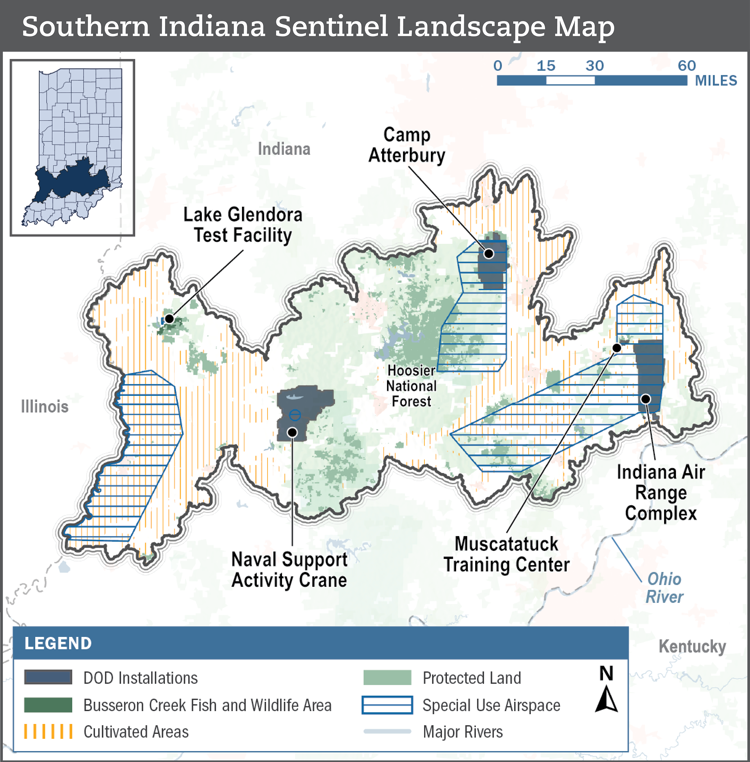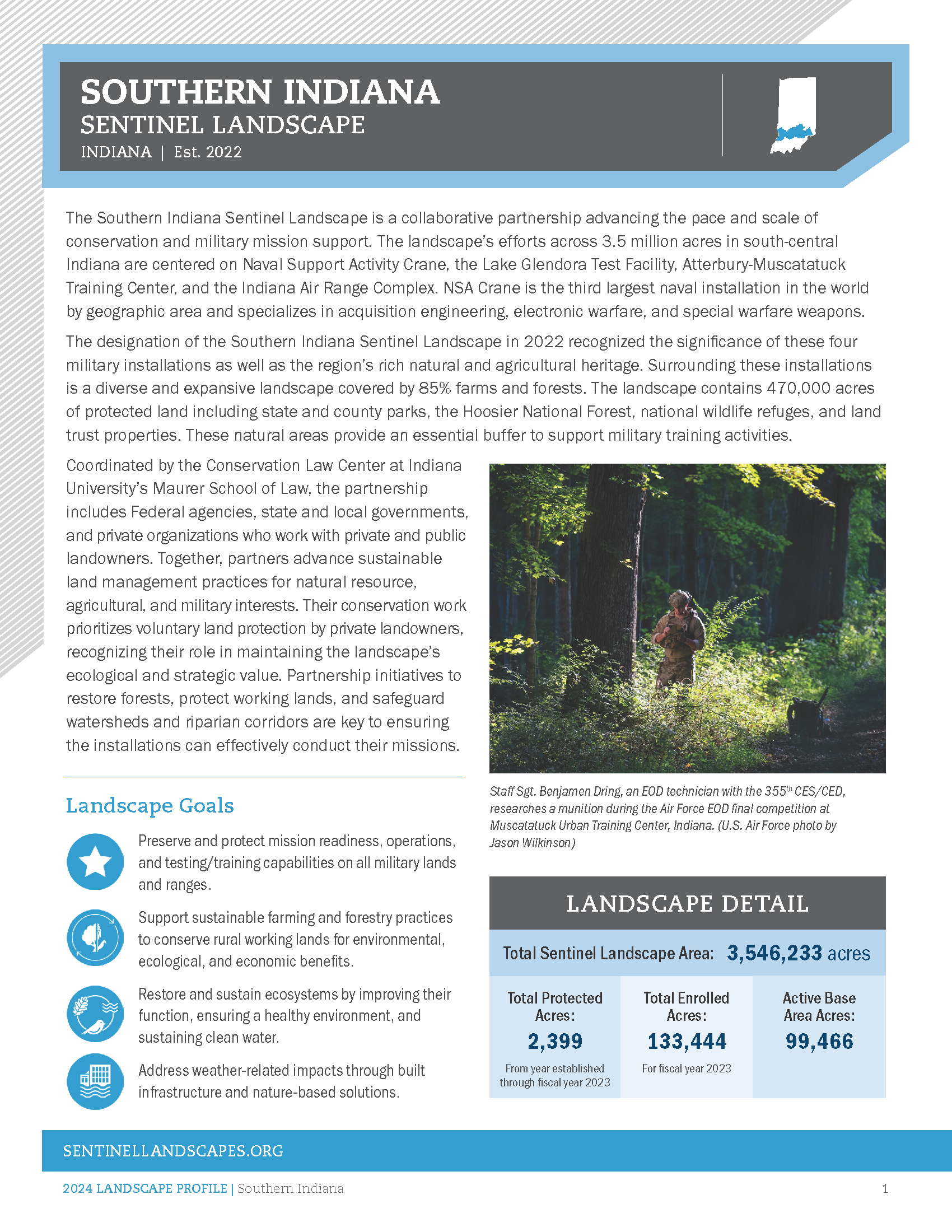Southern Indiana Sentinel Landscape
-
Indiana
-
Established 2022
About
The Southern Indiana Sentinel Landscape is a collaborative partnership advancing the pace and scale of conservation and military mission support. The landscape’s efforts across 3.5 million acres in south-central Indiana are centered on Naval Support Activity Crane, the Lake Glendora Test Facility, Atterbury-Muscatatuck Training Center, and the Indiana Air Range Complex. NSA Crane is the third largest naval installation in the world by geographic area and specializes in acquisition engineering, electronic warfare, and special warfare weapons.
The designation of the Southern Indiana Sentinel Landscape in 2022 recognized the significance of these four military installations as well as the region’s rich natural and agricultural heritage. Surrounding these installations is a diverse and expansive landscape covered by 85% farms and forests. The landscape contains 470,000 acres of protected land including state and county parks, the Hoosier National Forest, national wildlife refuges, and land trust properties. These natural areas provide an essential buffer to support military training activities.
Coordinated by the Conservation Law Center at Indiana University’s Maurer School of Law, the partnership includes Federal agencies, state and local governments, and private organizations who work with private and public landowners. Together, partners advance sustainable land management practices for natural resource, agricultural, and military interests. Their conservation work prioritizes voluntary land protection by private landowners, recognizing their role in maintaining the landscape’s ecological and strategic value. Partnership initiatives to restore forests, protect working lands, and safeguard watersheds and riparian corridors are key to ensuring the installations can effectively conduct their missions.

Total Funding by Partner
| Partner | FY2022 | FY2023 |
|---|---|---|
| USDA | $0.00M | $3.79M |
| DoD | $0.00M | $0.50M |
| DOI | $0.01M | $0.10M |
| State | $1.18M | $0.38M |
| Local | $0.00M | $0.00M |
| Private | $3.34M | $4.85M |
Total Acres Protected and Enrolled
| Acres Protected (Since Designation) | 2399 |
|---|---|
| Acres Enrolled (During FY23) | 133445 |
Our Partners
Federal Partners
Other
- American Bird Conservancy
- Cardinal Land Conservancy
- Conservation Cropping Systems Initiative
- Conservation Law Center
- Davey Resource Group Inc.
- Duke Energy
- Friends of Lake Monroe
- Hardwood Ecosystem Experiment/Purdue
- Indiana Ag Nutrient Alliance
- Indiana Association of Soil and Water Conservation Districts
- Indiana Corn Marketing Council
- Indiana Forestry and Woodland Owners Association
- Indiana Prescribed Fire Council
- Indiana Soybean Alliance
- Indiana Wildlife Federation
- IU Environmental Resilience Institute
- Knox County Soil and Water Conservation District
- Lake Monroe Water Fund
- Let the Sunshine IN (LSSI)
- Monarch Joint Venture
- National Wild Turkey Federation
- Pheasants Forever
- Quail Forever
- Radius Indiana
- Regional Opportunities Initiative
- Sam Shine Foundation
- Sierra Club Hoosier Chapter Winding Waters Group
- State of Indiana Cooperative Invasives Management
- The Nature Conservancy
- Uplands Science and Technology Foundation
- White River Military Coordination Alliance
Resources
-

Southern Indiana Sentinel Landscape Profile
Meet the Coordinators

Michael Spalding
mspalding@sentinellandscapes.org
Michael Forest Spalding is the Coordinator for the Southern Indiana Sentinel Landscape with the Conservation Law Center in Bloomington, Indiana. Michael earned a Bachelor of Science in Forestry from Purdue University’s College of Agriculture in 2005. Since that time, he has performed conservation work in 55 counties throughout Indiana. He began his career as a field forester with a forestry consulting firm and has spent the past 15 years managing over 100,000 acres of public forests at Jackson-Washington, Yellowwood, and Morgan-Monroe State Forests as well as Atterbury-Muscatatuck Training Center. Michael brings a vast array of experience on both private and public lands in southern Indiana as well as a thorough knowledge of landscape-level threats to conservation and the work needed to restore the landscape.

Rob McCrea
Rob McCrea is the Landscape Conservation Attorney at the Conservation Law Center. His practice focuses on land conservation projects in Indiana with a particular focus on the Southern Indiana Sentinel Landscape. Rob earned a Bachelor of Science in Ecology and Natural History from Prescott College and a law degree from Lewis & Clark Law School. Prior to joining the team at Conservation Law Center, Rob was in private law practice at McCrea & McCrea and also worked as the Land Preservation Director at Sycamore Land Trust in Bloomington, Indiana. Rob’s experience working with landowners on conservation projects and conservation easements will help implement key components of the Southern Indiana Sentinel Landscape.